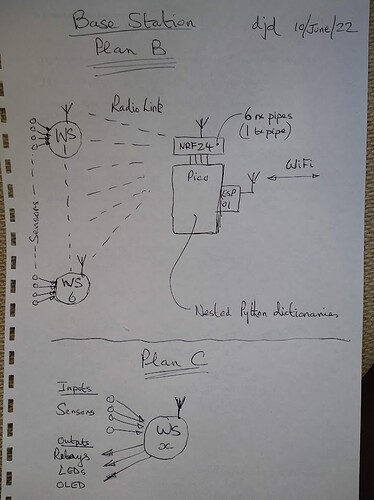Here's a rough sketch of Plan-B for the Base Station.
The NR24 radios can handle 6 receive pipes and a single transmit pipe.
That means it should be possible to create a 'star' radio network as per attached diagram.
I also believe I could create a set of nested Python dictionaries to hold the readings from the various remote WS.
So what happens is each remote station sends its readings on an ad-hoc basis.
The readings are held in a Python dictionary, so the last reading is always available.
The Python script in the RP2 could send these readings at set intervals and/or could also react to a command from Node-RED (via MQTT and ESP01) to send a reading on demand.
I have a second old weather station I intend to bring back to life so I can check out this idea.
Plan-C
At the moment my remote weather stations are just fitted with sensors (BME280, INA219, ADS1115)
however, I reckon they could be fitted with output devices like relays, LEDs, even OLED panel.
It just means implementing two-way radio communication (which the NRF24 radios support).
I haven't given this aspect much thought yet, but reckon it should be easy to send a command like this...
<WS_ID>, <device_ID>,
e.g. 101, gpio_6, on
100, gpio_4, off
So ALL the remote WS would receive these commands but only the WS that matched the WS_ID would react.
Although this is not an efficient use of the network, it does mean the 'pipe' selection is fairly straightforward.
In my particular application, this would open things up to become a more generic data acquisition and control system - rather than being limited to just a weather station.











